Alpine SPX-Z15M Manual
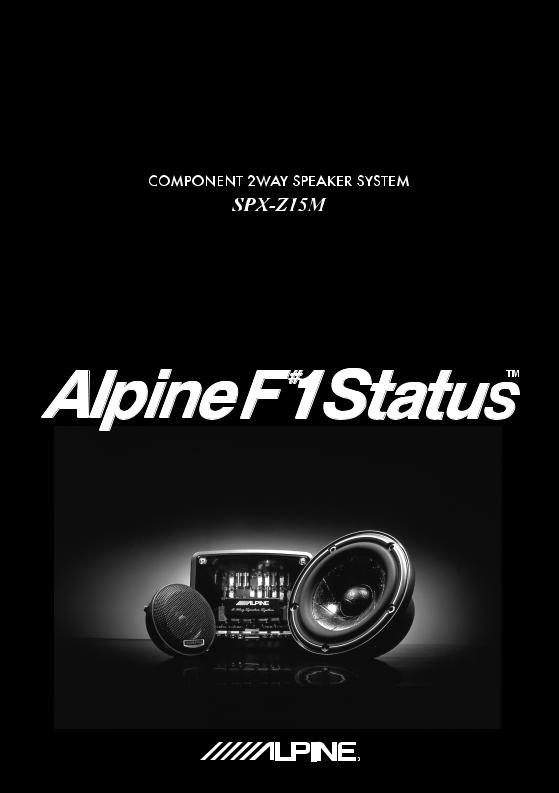

 Points to Observe for Safe Usage
Points to Observe for Safe Usage
•Read this manual carefully before starting operation and use this system safely. We cannot be responsible for problems resulting from failure to observe the instructions in this manual.
•This manual uses various pictorial displays to show how to use this product safely and to avoid harm to yourself and others and damage to your property. Here is what these pictorial displays mean. Understanding them is important for reading this manual.
•Meaning of displays
This label is intended to alert the user to the
presence of important operating instructions. Warning Failure to heed the instructions will result in
severe injury or death.
This label is intended to alert the user to the Caution presence of important operating instructions.
Failure to heed the instructions can result in injury or material damage.
 Warning
Warning
DO NOT DISASSEMBLE OR ALTER. Doing so may result in an accident, fire or electric shock.
KEEP SMALL OBJECTS SUCH AS BATTERY OUT OF THE REACH OF CHILDREN. Swallowing them may result in serious injury. If swallowed, consult a physician immediately.
DO NOT INSTALL IN LOCATIONS WHICH MIGHT HINDER VEHICLE OPERATION, SUCH AS THE STEERING WHEEL OR GEARSHIFT. Doing so may obstruct forward vision or hamper movement etc. and results in serious accident.
DO NOT DAMAGE PIPE OR WIRING WHEN DRILLING HOLES. When drilling holes in the chassis for installation, take precautions so as not to contact, damage or obstruct pipes, fuel lines, tanks or electrical wiring. Failure to take such precautions may result in fire.
DO NOT USE BOLTS OR NUTS IN THE BRAKE OR STEERING SYSTEMS TO MAKE GROUND CONNECTIONS. Bolts or nuts used for the brake or steering systems (or any other safety-related system), or tanks should NEVER be used for installations or ground connections. Using such parts could disable control of the vehicle and cause fire etc.
DO NOT INSTALL THE MONITOR NEAR THE PASSENGER SEAT AIR
BAG. If the unit is not installed correctly the air bag may not function correctly and when triggered the air bag may cause the monitor to spring upwards causing an accident and injuries.
MAKE THE CORRECT CONNECTIONS. Failure to make the proper connections may result in fire or product damage.
Points à respecter pour une utilisation sûre
•Lire attentivement ce manuel avant de commencer l’opération et l’utilisation du système en toute sécurité. Nous dégageons toute responsabilité des problèmes résultant du non-respect des instructions décrites dans ce manuel.
•Ce manuel utilise divers affichages illustrés pour montrer comment utiliser cet appareil en toute sécurité, pour éviter de s’exposer soi-même et les autres personnes aux dangers et pour éviter d’endommager l’appareil. Voici la signification de ces affichages illustrés. Il est important de bien les comprendre pour la lecture de ce manuel.
•Signification des affichages
Cette étiquette a pour but de prévenir l’utilisateur de la présence d’instructions impor-
Avertissement tantes. Si ces instructions ne sont pas suivies, des blessures graves ou mortelles ris-
quent d’être occasionnées.
Cette étiquette a pour but de prévenir l’utilisa-
teur de la présence d’instructions importantes. Attention Si ces instructions ne sont pas suivies, des
blessures ou des dommages matériels risquent d’être occasionnés.
 Avertissement
Avertissement
NE PAS DESASSEMBLER NI MODIFIER L’APPAREIL. Il y a risque d’accident, d’incendie ou de choc électrique.
GARDER LES PETITS OBJETS COMME LES PILES HORS DE PORTEE DES ENFANTS. L’ingestion de tels objets peut entraîner de graves blessures. En cas d’ingestion, consulter immédiatement un médecin.
NE PAS INSTALLER A DES ENDROITS SUSCEPTIBLES D’ENTRAVER LA CONDUITE DU VEHICULE, COMME LE VOLANT OU LE LEVIER DE VITESSES. La vue vers l’avant pourrait être obstruée ou les mouvements gênés, etc., et provoquer un accident grave.
NE PAS ENDOMMAGER DE CONDUITES NI DE CABLES LORS DU FORAGE DES TROUS. Lors du forage de trous dans le châssis en vue de l’installation, veiller à ne pas entrer en contact, endommager ni obstruer de conduites, de tuyaux à carburant ou de fils électriques. Le non-respect de cette précaution peut entraîner un incendie.
NE PAS UTILISER DES ECROUS NI DES BOULONS DU CIRCUIT DE FREINAGE OU DE DIRECTION POUR LES CONNEXIONS DE MASSE. Les boulons et les écrous utilisés pour les circuits de freinage et de direction (ou de tout autre système de sécurité) ou les réservoirs ne peuvent JAMAIS être utilisés pour l’installation ou la liaison à la masse. L’utilisation de ces organes peut désactiver le système de contrôle du véhicule et causer un incendie, etc.
NE PAS INSTALLER LE MONITEUR PRES DU COUSSIN D’AIR DU
PASSAGER. Si l’appareil n’est pas installé correctement, il risque d’empêcher le fonctionnement du coussin d’air, et si le coussin se déploie, l’appareil risque d’être projeté dans l’habitacle, causant un accident et des blessures.
EFFECTUER CORRECTEMENT LES CONNEXIONS. Il y a risque de blessures ou de dommages à l’appareil.
 Caution
Caution
USE SPECIFIED ACCESSORY PARTS AND INSTALL THEM SECURELY.
Be sure to use only the specified accessory parts. Use of other than designated parts may damage this unit internally or may not securely install the unit in place. This may cause parts to become loose resulting in hazards or product failure.
DO NOT INSTALL IN LOCATIONS WITH HIGH MOISTURE OR DUST.
Avoid installing the unit in locations with high incidence of moisture or dust. Moisture or dust that penetrates into this unit may result in product failure.
HAVE THE WIRING AND INSTALLATION DONE BY EXPERTS. The wiring and installation of this unit requires special technical skill and experience. To ensure safety, always contact the dealer where you purchased this product to have the work done.
ARRANGE THE WIRING SO IT IS NOT CRIMPED OR PINCHED BY A SHARP METAL EDGE. Route the cables and wiring away from moving parts (like the seat rails) or sharp or pointed edges. This will prevent crimping and damage to the wiring. If wiring passes through a hole in metal, use a rubber grommet to prevent the wire’s insulation from being cut by the metal edge of the hole.
HALT USE IMMEDIATELY IF A PROBLEM APPEARS. Failure to do so may cause personal injury or damage to the product. Return it to your authorized Alpine dealer or the nearest Alpine Service Center for repairing.
 Attention
Attention
UTILISER LES ACCESSOIRES SPECIFIES ET LES INSTALLER CORRECTEMENT.
Utiliser uniquement les accessoires spécifiés. L’utilisation d’autres composants que les composants spécifiés peut causer des dommages internes à cet appareil ou son installation risque de ne pas être effectuée correctement. Les pièces utilisées risquent de se desserrer et de provoquer des dommages ou une défaillance de l’appareil.
NE PAS INSTALLER A DES ENDROITS TRES HUMIDES OU POUSSIEREUX. Eviter d’installer l’appareil à des endroits soumis à une forte humidité ou à de la poussière en excès. La pénétration d’humidité ou de poussière à l’intérieur de cet appareil risque de provoquer une défaillance.
FAIRE INSTALLER LE CABLAGE ET L’APPAREIL PAR DES EXPERTS. Le câblage et l’installation de cet appareil requiert des compétences techniques et de l’expérience. Pour garantir la sécurité, faire procéder à l’installation de cet appareil par le distributeur qui vous l’a vendu.
FAIRE CHEMINER LE CABLAGE DE MANIERE A NE PAS LE COINCER CONTRE UNE ARETE METALLIQUE. Faire cheminer les câbles à l’écart des pièces mobiles (comme les rails d’un siège) et des arêtes acérées ou pointues. Cela évitera ainsi de coincer et d’endommager les câbles. Si un câble passe dans un orifice métallique, utiliser un passe-cloison en caoutchouc pour éviter que la gaine isolante du câble ne soit endommagée par le rebord métallique de l’orifice.
INTERROMPRE TOUTE UTILISATION EN CAS DE PROBLEME. Le non-respect de cette précaution peut entraîner des blessures ou endommager l’appareil. Retourner l’appareil auprès du distributeur Alpine agréé ou un centre de service après-vente Alpine en vue de la réparation.
English/Français
1

Contents / Contenu
Installation / Installation |
|
Parts List / Liste des pièces ................................................................................... |
3 |
Woofer Installation / Installation du woofer ............................................................ |
4 |
Tweeter Installation / Installation du tweeter .......................................................... |
5 |
Network Installation / Installation du circuit ............................................................ |
6 |
Network connections / Connexions du circuit ........................................................ |
7 |
Crossover Network / Circuit répartiteur |
|
Crossover Network Introduction / Introduction au circuit répartiteur ................ |
9/27 |
Jumper Group Function / Fonction de groupe cavalier ................................... |
10/28 |
System Type 1 / Type de système 1 ................................................................ |
12/30 |
System Description / Description du système ............................................. |
12/30 |
Network Jumper Setting / Réglage du cavalier du circuit ........................... |
14/32 |
System Type 2 / Type de système 2 ................................................................ |
18/36 |
System Description / Description du système ............................................. |
18/36 |
Network Jumper Setting / Réglage du cavalier du circuit ........................... |
19/37 |
System Type 3 / Type de système 3 ................................................................ |
21/39 |
System Description / Description du système ............................................. |
21/39 |
Network Jumper Setting / Réglage du cavalier du circuit ........................... |
22/40 |
System Type 4 / Type de système 4 ................................................................ |
24/42 |
System Description / Description du système .............................................. |
24/42 |
Network Jumper Setting / Réglage du cavalier du circuit ........................... |
25/43 |
Others / Autres |
|
External dimensions / Dimensions externes ........................................................ |
44 |
Specifications / Spécifications .............................................................................. |
46 |
2
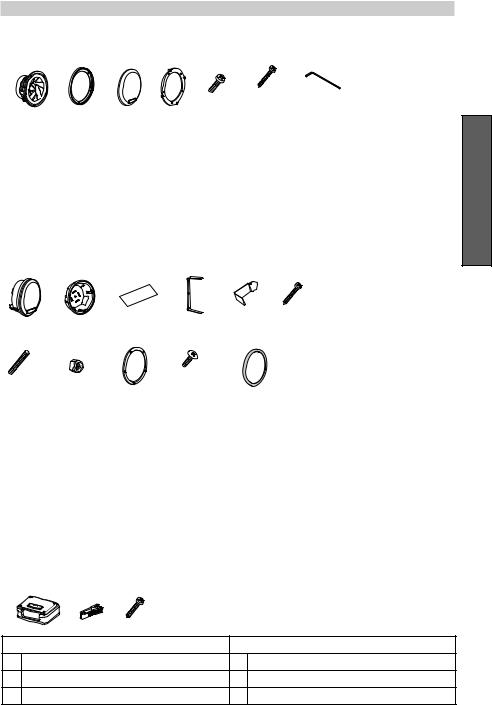
Parts List / Liste des pièces
Woofer / Woofer
1 |
2 |
3 |
4 |
5 |
6 |
7 |
X5 X5
|
|
English |
|
Français |
||||
|
|
|
|
|
|
|
|
|
1 |
Main Unit |
|
5 |
Screw M4 x 10 |
1 |
Unité principale |
5 |
Vis M4 x 10 |
2 |
Grille Ring |
|
6 |
Screw ø4 x 19 |
2 |
Bague de la grille |
6 |
Vis ø4 x 19 |
3 |
Grille |
|
7 |
Hexagonal |
3 |
Grille |
7 |
Clé hexagonale |
4 |
Adapter Ring |
|
|
Wrench |
4 |
Bague d’accouplement |
|
|
Tweeter / Tweeter
8 9 p q w e
aisçEnglish/Fran
|
|
X2 |
|
X4 |
X5 |
r |
t |
y |
u |
i |
|
|
|
English |
|
Français |
||||
|
|
|
|
|
|
|
|
|
8 |
Main Unit |
|
e |
Screw ø4 x 19 |
8 |
Unité principale |
e |
Vis ø4 x 19 |
9 |
Mounting Cup |
|
r |
Screw M4 x 25 |
9 |
Coupelle de |
r |
Vis M4 x 25 |
|
|
|
t |
M4 Nut |
|
montage |
t |
Écrou M4 |
|
|
|
|
|
||||
p |
Terminal Cover |
|
y |
Mounting Ring |
p |
Couvre-bornes |
y |
Bague de montage |
q |
Spring |
|
u |
Screw ø4 x 12 |
q |
Ressort |
u |
Vis ø4 x 12 |
w |
Mounting Clip |
|
i |
Gasket |
w |
Collier de fixation |
i |
Garniture |
2-way crossover network / Circuit répartiteur à 2 voies
o |
; |
a |
|
|
|
|
X3 |
|
|
English |
Français |
o Crossover network |
o Circuit répartiteur |
||
; Jumper Puller |
|
; Mécanisme de tirage du cavalier |
|
a Screw ø4 x 19 |
|
a Vis ø4 x 19 |
|
3
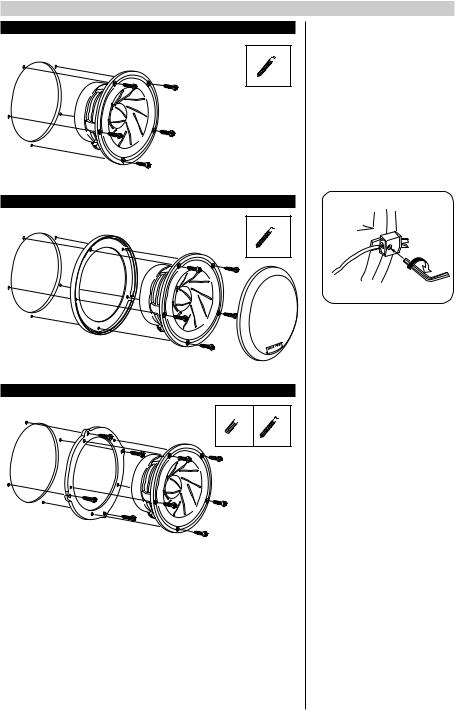
Woofer Installation / Installation du woofer
Installation without a grille / Installation sans grille
6 
X5
Installation with a grille / Installation avec grille
6 
X5
Installation with adapter rings / Installation avec bagues d’accouplement
5 6
6 
X5 X4
Speaker Wire Connections/ Raccordement des fils d’enceinte
1.Insert the speaker wires through the connection holes. / Insérer les fils d’enceinte dans les trous de raccordement.
2.Fasten with a hexagonal wrench. / Serrer avec une clé hexagonale.
4
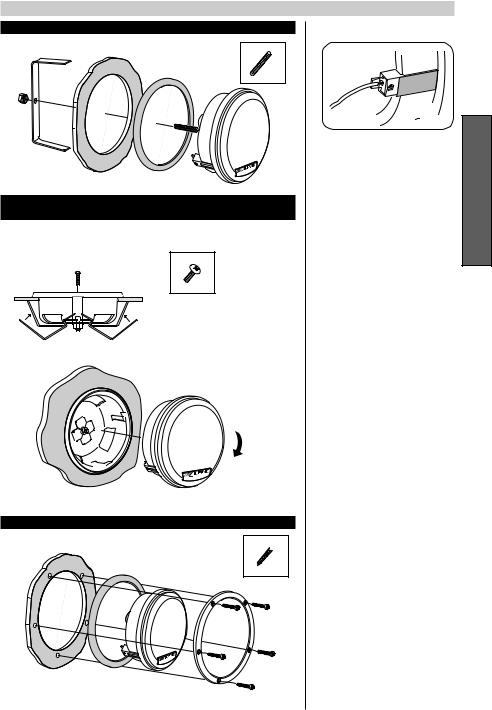
Tweeter Installation / Installation du tweeter
Installation with springs / Installation avec ressorts
r
X1
Installation with a mounting cup (Installation from the front) /
Installation avec coupelle de montage (Installation par l’avant)
u
X1
Installation with fastening rings / Installation avec bagues de serrage
e
X5
Apply the supplied terminal cover to prevent short circuits from occurring when metallic or other conductors are in the vicinity of the installation area. / Appliquer le couvre-bornes fourni afin d’éviter que des court-circuits ne se produisent lorsque des conducteurs métalliques ou autres se trouvent à proximité de la zone d’installation.
aisçEnglish/Fran
5
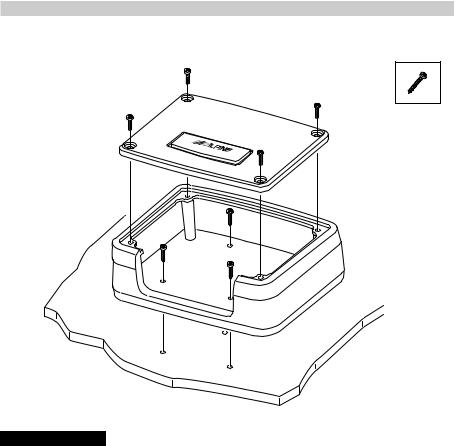
Network Installation / Installation du circuit
a
X3
Note /Remarque:
Do not install the Crossover network where it will be exposed to moisture such as under the floor mat or near the air conditioner. This may cause a malfunction./
Ne pas installer le circuit répartiteur dans un endroit où il sera exposé à l’humidité, comme sous la moquette ou près du climatiseur. Cela risque de provoquer un mauvais fonctionnement.
6
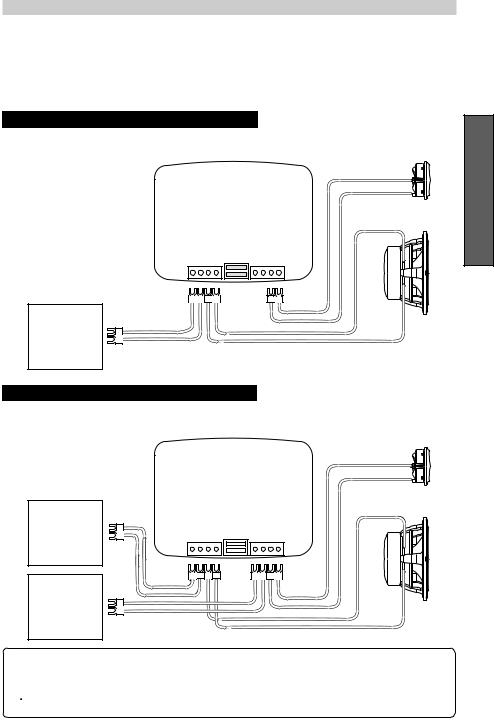
Network connections / Connexions du circuit
Insert the signal link jumpers highlighted in gray firmly following each connection example. If the jumper is not connected properly as described, it might result in malfunction of amplifier.
Insérez fermement les cavaliers de liaison de signal soulignés en gris en suivant chaque exemple de raccordement. Si le cavalier n’est pas relié correctement comme décrit, il pourrait avoir comme conséquence le défaut de fonctionnement de l’amplificateur.
Connection Example 1 / Exemple de connexion 1
When connecting to single amp/single wiring /
Lors du raccordement avec un seul amplificateur/câblage simple
SIGNAL
LINK
+
–
Amplifier/
Amplificateur
aisçEnglish/Fran
Connection Example 2 / Exemple de connexion 2
When connecting to bi-amp/bi-wiring /
Lors du raccordement avec deux amplificateurs/câblage double
|
|
|
Amplifier/ |
|
SIGNAL |
Amplificateur |
|
LINK |
|
+ |
|
|
– |
|
|
|
|
Amplifier/ |
|
|
Amplificateur |
|
|
 Caution
Caution
 Précaution
Précaution
Connect properly by following the manual. Otherwise it might result in fire or accident.
Reliez correctement en suivant le manuel. Autrement il pourrait avoir comme conséquence le feu ou des accidents.
7
8

Crossover Network Introduction
It is common knowledge that the automotive interior is one of the most inhospitable environments for high-fidelity sound, and that every vehicle poses its own unique set of installation and acoustic challenges. While many of these problems can often be overcome with proper speaker placement, equalization, or other techniques, the attempt is a time consuming task without guaranteed results.Yet with all these tools and methods available, it is surprising to realize that one of the most powerful tuning tools has been misunderstood or neglected by so many for so long. It is for this reason that Alpine has developed the most advanced crossover network design in the history of car audio.
Much of the difference between demo-board and in-car performance can be attributed to the fact that crossover networks have been traditionally tuned for only one specific application – usually the demo-board. Without taking into account typical real world installations, the transition between drivers and resultant frequency response will be degraded for the majority of vehicles that installers are confronted with today. Through Alpine’s unique phase coherent flat summation design methodology, however, it is now possible to optimize performance for a variety of installations by intentionally altering various filter characteristics. By achieving an “in-phase” condition between drivers in the overlapping frequency range at the listening position, image smear, response aberrations and other typical problems can be dramatically reduced or eliminated altogether. This “phase linkage” technique can be thought of as a kind of passive time correction in the crossover region.
With Alpine’s introduction of such revolutionary processing technologies as digital time correction and adaptive equalization, all of this may seem superlative. Unfortunately however, such processing can significantly increase system complexity and therefore may not be practical for every situation. Additionally, without careful use of time correction for each individual speaker in the system, integration problems between them can remain. Subsequently, it may be advantageous to use such processing to compensate for seating position bias in conjunction with the phase correction of the passive network for the transition between individual drivers. Simply stated, the flexibility of the AlpineF#1Status™ crossover network allows it to be a complimentary solution for achieving the best of both worlds, either as a stand alone solution or an integral component of a partially active system.
As with all AlpineF#1Status™ products, it is the attention to the smallest details that truly brings out ultimate performance... or in a word, MicroDynamics™. From the hand coated crosscut wood fiber cones to the symmetric drive motor structures, nothing is left to chance. This philosophy is carried throughout every aspect of the SPX-Z15M speaker system, including the components, layout and design of the crossover network. All series capacitors are the highest grade metalized polypropylene, and all series inductors are heavy gauge air core. All elements are intentionally placed in such a way to as to minimize any chance for magnetic or thermal influence, and all signal path lengths are minimized with extra heavy circuit board traces. In the end, this level of quality and attention to detail has but one purpose, to bring true sonic realism to the automotive environment once and for all.
English
9

Jumper Group Function
Although recommendations are made for the most common system types in the following pages, there are actually over 250 unique and useful jumper combinations available for a wide variety of vehicles, installations and personal tastes. While this flexibility has obvious advantages, too many choices can also be confusing. Therefore, it will be helpful to understand the function of each jumper group in order to tune the network more effectively:
TW-HP:
Although essentially a selectable high-pass filter, this section provides the major part of the phase correction and response compensation of the network. By altering the slope, Q, cut-off frequency and phase shift of the high-pass filter, it is possible to create “phase linkage” with the woofer. This proper summation in the frequency and time domains is what produces the seamless blend necessary for optimum imaging, staging, focus and tonal balance in a multi-element system.
These relationships are affected by the distance and angle of both drivers relative to the listener, their proximity to each other, and certainly the vehicle’s interior as well. While it is beyond the scope of this manual to describe each potential network combination in detail, the following filter types are possible for the high-pass section of the network:
R1
+
R2
R3
R4
R5
–
|
|
BYPASS |
|
|
|
6dB/45° |
C1 |
C2 |
|
|
|
|
|
|
|
|
|
4dB/30° |
|
|
|
IN |
OUT |
2dB/15° |
|
HP-1 |
HP-4 |
+ |
|
5-HP |
2-HP |
3-HP |
|
||
0dB/0° |
|
|
|||
-2dB |
|
|
|
– |
|
|
L1 |
L2 |
L3 |
|
|
|
|
|
|||
-4dB |
|
|
OUT |
IN |
|
|
|
|
|
R1 = 1.0Ω
R2 = 2.2Ω
R3 = 3.9Ω
R4 = 5.6Ω
R5 = 8.2Ω
C1 = 4.7µF
C2 = 12µF
L1 = 0.17mH
L2 = 0.24mH
L3 = 0.52mH
1st Order: |
2nd Order: |
3rd Order: |
4th Order: |
|
• No HP jumpers • |
HP1 + HP2 + HP3 + HP4 |
• HP1 + HP2 |
• HP2 + HP4 + HP5 |
|
• HP1 + HP4 |
• |
HP1 + HP2 + HP3 + HP4 + HP5 |
• HP1 + HP3 |
• HP3 + HP4 + HP5 |
|
• |
HP1 + HP2 + HP4 |
• HP1 + HP2 + HP3 |
|
|
• |
HP1 + HP3 + HP4 |
• HP1 + HP2 + HP3 + HP5 |
|
|
• |
HP1 + HP4 + HP5 |
• HP1 + HP2 + HP5 |
|
|
• |
HP2 + HP3 + HP4 |
|
|
|
• |
HP2 + HP4 |
|
|
|
• |
HP3 + HP4 |
|
|
TW PHASE:
This jumper group provides a means by which the tweeter connection can easily be reversed. By flipping the tweeter polarity “in” or “out” of phase (0° or 180°), it is possible to achieve proper phase linkage for a wider variety of applications.
10

TW LEVEL:
In general, this section provides precise level adjustment for optimum performance or personal taste. However, it also allows for “tilting” of the filter frequency response in order to compensate for the natural high frequency roll-off associated with off-axis listening angles. In other words, tweeter level jumper selection will have a specific effect upon both Q and cut-off frequency of each high-pass filter configuration. This effect can be seen in the filter transfer function graphs for the various system types. If the TW-HP section is set to bypass in favor of an electronic crossover, the off-axis feature will no longer function, but basic level adjustment will still be possible.
WF-LP:
In addition to functioning as a selectable low-pass filter, this section also provides part of the phase correction and response compensation of the network. By shifting the phase appropriately within the crossover region, it is possible to achieve “phase linkage” with the tweeter, producing a seamless blend or transition between the two drivers. This relationship is affected by the distance and angle of both drivers relative to the listener, but also by their proximity to each other. Since in this case, most of the manipulation of the overlapping region is being done in the tweeter high-pass filter, less variation of the woofer low-pass is necessary. Subsequently there are basically two possibilities for the LPF:
• |
LP1 = low Q 1st-2nd order roll off (starting at 6dB/oct. ending at 9dB/oct.) |
English |
||
|
||||
• |
LP2 = semi-1st Order (shallow 3-4dB/oct. roll off) |
|
||
|
|
|
|
|
|
|
BYPASS |
|
|
+L4
+
–
SIGNAL LINK:
R10
C3
1-LP |
|
2-LP |
R10 = 2.2Ω
C3 = 33µF
L4 = 0.39mH
–
The signal link jumpers provide a parallel connection between the input sides of the two terminal blocks, allowing a single input connection to be made without the use of extra terminals or wiring.
Caution:
These jumpers must be removed when used in a bi-amp configuration to prevent possible damage to amplifiers.
11

System Type 1
System Description
In this system type, the woofer and tweeter are mounted close together. While the kick panel is one of the more common locations to achieve this, it is certainly not the only one. What is most significant, is that by mounting the two drivers in close proximity with a minimized off-axis angle at the greatest distance possible from the listening position, it provides one of the best arrangements for optimum imaging in the vehicle. Since there are varying degrees of axis and pathlength that will be achievable for each driver in typical installations, four basic configurations are provided to accommodate the most common cases.
•Type-1A is the default setting of the network, and assumes essentially on-axis positioning with equal pathlength of both woofer and tweeter to the listening position.
•Type-1A (Option) is as above, but provides a more shallow roll-off and lower Q for the tweeter high-pass filter as an alternative.
12
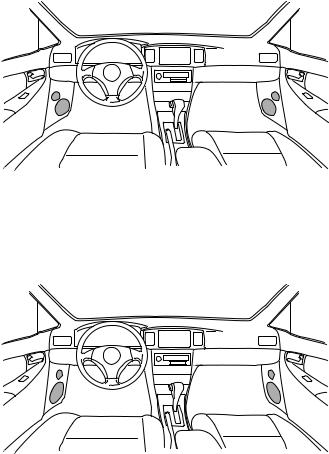
•Type-1B is optimized for installations where build out for better on-axis positioning is possible, and the tweeter is mounted vertical over the woofer.
|
|
|
|
|
|
|
|
|
|
|
|
|
|
|
|
|
|
|
|
|
|
|
|
|
|
|
|
|
|
|
|
|
|
|
|
|
|
|
|
|
|
|
|
|
|
|
|
|
|
|
|
|
|
|
|
|
|
|
|
|
|
|
|
|
• Type-1C is for particular cases where flat to the surface mounting is required, and the |
English |
|||||||||||
tweeter is mounted over the woofer necessitating some delay for proper alignment of the |
||||||||||||
|
||||||||||||
two drivers. |
|
|||||||||||
|
|
|
|
|
|
|
|
|
|
|
|
|
|
|
|
|
|
|
|
|
|
|
|
|
|
|
|
|
|
|
|
|
|
|
|
|
|
|
|
|
|
|
|
|
|
|
|
|
|
|
|
|
|
|
|
|
|
|
|
|
|
|
|
|
|
|
|
|
|
|
|
|
|
|
|
|
|
13

System Type 1
Network Jumper Setting
Type-1A: Pathlength to the listening position is considered to be equal in this case, with relative on-axis positioning of both drivers. Phase linkage accomplished with a relatively high Q 3rd Order high-pass filter on the tweeter, resulting in a 12dB/oct. roll-off at the starting point that steepens to 18dB/oct. below 2kHz. The woofer low-pass is a semi- 1st Order with a very gradual slope of 3-4dB/ oct. As a result, the acoustic crossover point between the two drivers is 2.8kHz.
TW HP
HP-1 |
HP-2 |
HP-3 |
HP-4 |
HP-5 |
BYPASS |
10
0
–10
–20
–30
–40
–50 |
|
|
|
|
|
|
2.0Hz 3.0Hz |
100Hz |
300Hz |
1.0kHz |
3.0kHz |
10kHz |
30kHz |
TW PHASE
IN |
OUT |
IN |
OUT |
WF LP
LP-1 |
LP-2 |
BYPASS |
TW LEVEL
+6dB/45° |
+4dB/30° |
+2dB/15° |
0dB/0° |
–2dB |
–4dB |
SPX—Z15M
SIGNAL
LINK
+
—
Notes:
•Highlighted tweeter level jumpers are the recommended settings for each configuration, but some user adjustment may be desirable.
•Transfer function simulations only illustrate the effect of the filter upon the input signal, and therefore do not represent the actual frequency response of the system.
•If separate channels of amplification are used (bi-wire mode), the appropriate signal link jumpers must be removed.
14
